Jiaxiang Li
Federated Learning on Riemannian Manifolds: A Gradient-Free Projection-Based Approach
Jul 30, 2025Abstract:Federated learning (FL) has emerged as a powerful paradigm for collaborative model training across distributed clients while preserving data privacy. However, existing FL algorithms predominantly focus on unconstrained optimization problems with exact gradient information, limiting its applicability in scenarios where only noisy function evaluations are accessible or where model parameters are constrained. To address these challenges, we propose a novel zeroth-order projection-based algorithm on Riemannian manifolds for FL. By leveraging the projection operator, we introduce a computationally efficient zeroth-order Riemannian gradient estimator. Unlike existing estimators, ours requires only a simple Euclidean random perturbation, eliminating the need to sample random vectors in the tangent space, thus reducing computational cost. Theoretically, we first prove the approximation properties of the estimator and then establish the sublinear convergence of the proposed algorithm, matching the rate of its first-order counterpart. Numerically, we first assess the efficiency of our estimator using kernel principal component analysis. Furthermore, we apply the proposed algorithm to two real-world scenarios: zeroth-order attacks on deep neural networks and low-rank neural network training to validate the theoretical findings.
Scalable Parameter and Memory Efficient Pretraining for LLM: Recent Algorithmic Advances and Benchmarking
May 28, 2025Abstract:Fueled by their remarkable ability to tackle diverse tasks across multiple domains, large language models (LLMs) have grown at an unprecedented rate, with some recent models containing trillions of parameters. This growth is accompanied by substantial computational challenges, particularly regarding the memory and compute resources required for training and fine-tuning. Numerous approaches have been explored to address these issues, such as LoRA. While these methods are effective for fine-tuning, their application to pre-training is significantly more challenging due to the need to learn vast datasets. Motivated by this issue, we aim to address the following questions: Can parameter- or memory-efficient methods enhance pre-training efficiency while achieving performance comparable to full-model training? How can the performance gap be narrowed? To this end, the contributions of this work are the following. (1) We begin by conducting a comprehensive survey that summarizes state-of-the-art methods for efficient pre-training. (2) We perform a benchmark evaluation of several representative memory efficient pre-training approaches to comprehensively evaluate their performance across model sizes. We observe that with a proper choice of optimizer and hyperparameters, full-rank training delivers the best performance, as expected. We also notice that incorporating high-rank updates in low-rank approaches is the key to improving their performance. (3) Finally, we propose two practical techniques, namely weight refactorization and momentum reset, to enhance the performance of efficient pre-training methods. We observe that applying these techniques to the low-rank method (on a 1B model) can achieve a lower perplexity than popular memory efficient algorithms such as GaLore and Fira, while simultaneously using about 25% less memory.
Enhancing the Efficiency of Complex Systems Crystal Structure Prediction by Active Learning Guided Machine Learning Potential
May 13, 2025Abstract:Understanding multicomponent complex material systems is essential for design of advanced materials for a wide range of technological applications. While state-of-the-art crystal structure prediction (CSP) methods effectively identify new structures and assess phase stability, they face fundamental limitations when applied to complex systems. This challenge stems from the combinatorial explosion of atomic configurations and the vast stoichiometric space, both of which contribute to computational demands that rapidly exceed practical feasibility. In this work, we propose a flexible and automated workflow to build a highly generalizable and data-efficient machine learning potential (MLP), effectively unlocking the full potential of CSP algorithms. The workflow is validated on both Mg-Ca-H ternary and Be-P-N-O quaternary systems, demonstrating substantial machine learning acceleration in high-throughput structural optimization and enabling the efficient identification of promising compounds. These results underscore the effectiveness of our approach in exploring complex material systems and accelerating the discovery of new multicomponent materials.
Joint Demonstration and Preference Learning Improves Policy Alignment with Human Feedback
Jun 11, 2024Abstract:Aligning human preference and value is an important requirement for building contemporary foundation models and embodied AI. However, popular approaches such as reinforcement learning with human feedback (RLHF) break down the task into successive stages, such as supervised fine-tuning (SFT), reward modeling (RM), and reinforcement learning (RL), each performing one specific learning task. Such a sequential approach results in serious issues such as significant under-utilization of data and distribution mismatch between the learned reward model and generated policy, which eventually lead to poor alignment performance. We develop a single stage approach named Alignment with Integrated Human Feedback (AIHF), capable of integrating both human preference and demonstration to train reward models and the policy. The proposed approach admits a suite of efficient algorithms, which can easily reduce to, and leverage, popular alignment algorithms such as RLHF and Directly Policy Optimization (DPO), and only requires minor changes to the existing alignment pipelines. We demonstrate the efficiency of the proposed solutions with extensive experiments involving alignment problems in LLMs and robotic control problems in MuJoCo. We observe that the proposed solutions outperform the existing alignment algorithms such as RLHF and DPO by large margins, especially when the amount of high-quality preference data is relatively limited.
SLTrain: a sparse plus low-rank approach for parameter and memory efficient pretraining
Jun 04, 2024



Abstract:Large language models (LLMs) have shown impressive capabilities across various tasks. However, training LLMs from scratch requires significant computational power and extensive memory capacity. Recent studies have explored low-rank structures on weights for efficient fine-tuning in terms of parameters and memory, either through low-rank adaptation or factorization. While effective for fine-tuning, low-rank structures are generally less suitable for pretraining because they restrict parameters to a low-dimensional subspace. In this work, we propose to parameterize the weights as a sum of low-rank and sparse matrices for pretraining, which we call SLTrain. The low-rank component is learned via matrix factorization, while for the sparse component, we employ a simple strategy of uniformly selecting the sparsity support at random and learning only the non-zero entries with the fixed support. While being simple, the random fixed-support sparse learning strategy significantly enhances pretraining when combined with low-rank learning. Our results show that SLTrain adds minimal extra parameters and memory costs compared to pretraining with low-rank parameterization, yet achieves substantially better performance, which is comparable to full-rank training. Remarkably, when combined with quantization and per-layer updates, SLTrain can reduce memory requirements by up to 73% when pretraining the LLaMA 7B model.
Getting More Juice Out of the SFT Data: Reward Learning from Human Demonstration Improves SFT for LLM Alignment
May 29, 2024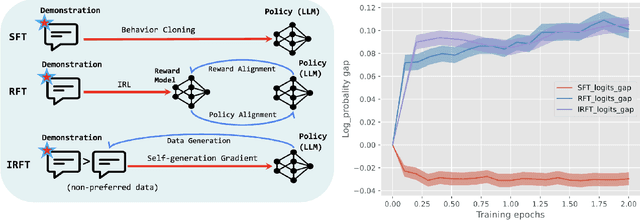
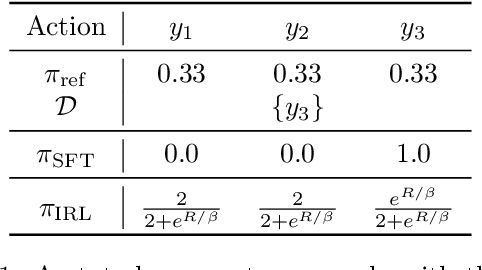
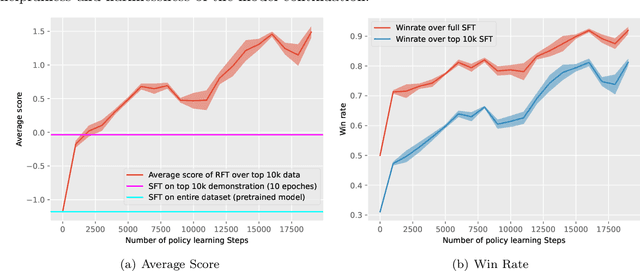

Abstract:Aligning human preference and value is an important requirement for contemporary foundation models. State-of-the-art techniques such as Reinforcement Learning from Human Feedback (RLHF) often consist of two stages: 1) supervised fine-tuning (SFT), where the model is fine-tuned by learning from human demonstration data; 2) Preference learning, where preference data is used to learn a reward model, which is in turn used by a reinforcement learning (RL) step to fine-tune the model. Such reward model serves as a proxy to human preference, and it is critical to guide the RL step towards improving the model quality. In this work, we argue that the SFT stage significantly benefits from learning a reward model as well. Instead of using the human demonstration data directly via supervised learning, we propose to leverage an Inverse Reinforcement Learning (IRL) technique to (explicitly or implicitly) build an reward model, while learning the policy model. This approach leads to new SFT algorithms that are not only efficient to implement, but also promote the ability to distinguish between the preferred and non-preferred continuations. Moreover, we identify a connection between the proposed IRL based approach, and certain self-play approach proposed recently, and showed that self-play is a special case of modeling a reward-learning agent. Theoretically, we show that the proposed algorithms converge to the stationary solutions of the IRL problem. Empirically, we align 1B and 7B models using proposed methods and evaluate them on a reward benchmark model and the HuggingFace Open LLM Leaderboard. The proposed methods show significant performance improvement over existing SFT approaches. Our results indicate that it is beneficial to explicitly or implicitly leverage reward learning throughout the entire alignment process.
SA-Attack: Speed-adaptive stealthy adversarial attack on trajectory prediction
Apr 19, 2024Abstract:Trajectory prediction is critical for the safe planning and navigation of automated vehicles. The trajectory prediction models based on the neural networks are vulnerable to adversarial attacks. Previous attack methods have achieved high attack success rates but overlook the adaptability to realistic scenarios and the concealment of the deceits. To address this problem, we propose a speed-adaptive stealthy adversarial attack method named SA-Attack. This method searches the sensitive region of trajectory prediction models and generates the adversarial trajectories by using the vehicle-following method and incorporating information about forthcoming trajectories. Our method has the ability to adapt to different speed scenarios by reconstructing the trajectory from scratch. Fusing future trajectory trends and curvature constraints can guarantee the smoothness of adversarial trajectories, further ensuring the stealthiness of attacks. The empirical study on the datasets of nuScenes and Apolloscape demonstrates the attack performance of our proposed method. Finally, we also demonstrate the adaptability and stealthiness of SA-Attack for different speed scenarios. Our code is available at the repository: https://github.com/eclipse-bot/SA-Attack.
Revisiting Zeroth-Order Optimization for Memory-Efficient LLM Fine-Tuning: A Benchmark
Feb 26, 2024
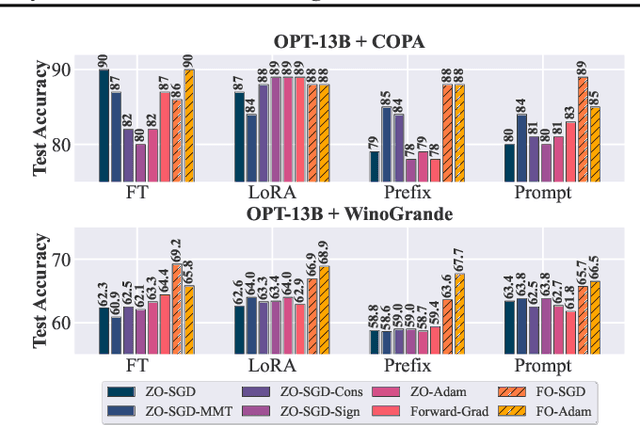


Abstract:In the evolving landscape of natural language processing (NLP), fine-tuning pre-trained Large Language Models (LLMs) with first-order (FO) optimizers like SGD and Adam has become standard. Yet, as LLMs grow {in size}, the substantial memory overhead from back-propagation (BP) for FO gradient computation presents a significant challenge. Addressing this issue is crucial, especially for applications like on-device training where memory efficiency is paramount. This paper proposes a shift towards BP-free, zeroth-order (ZO) optimization as a solution for reducing memory costs during LLM fine-tuning, building on the initial concept introduced by MeZO. Unlike traditional ZO-SGD methods, our work expands the exploration to a wider array of ZO optimization techniques, through a comprehensive, first-of-its-kind benchmarking study across five LLM families (Roberta, OPT, LLaMA, Vicuna, Mistral), three task complexities, and five fine-tuning schemes. Our study unveils previously overlooked optimization principles, highlighting the importance of task alignment, the role of the forward gradient method, and the balance between algorithm complexity and fine-tuning performance. We further introduce novel enhancements to ZO optimization, including block-wise descent, hybrid training, and gradient sparsity. Our study offers a promising direction for achieving further memory-efficient LLM fine-tuning. Codes to reproduce all our experiments are at https://github.com/ZO-Bench/ZO-LLM .
Zeroth-order Riemannian Averaging Stochastic Approximation Algorithms
Sep 25, 2023
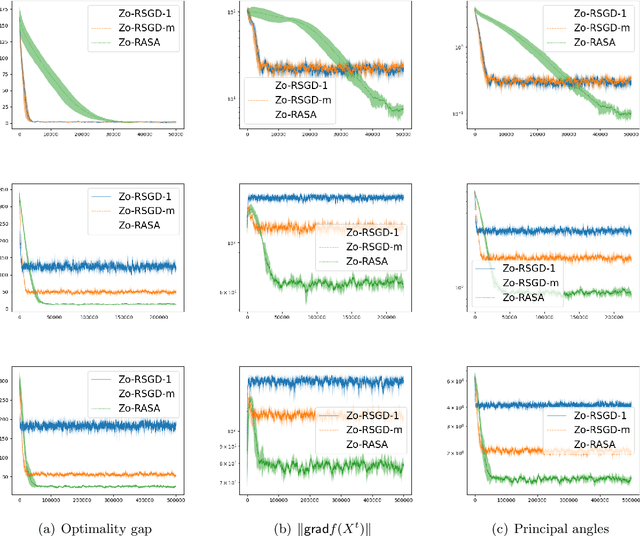
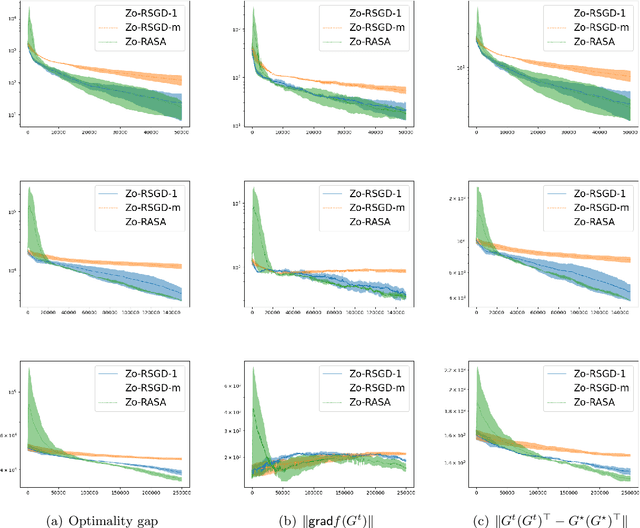
Abstract:We present Zeroth-order Riemannian Averaging Stochastic Approximation (\texttt{Zo-RASA}) algorithms for stochastic optimization on Riemannian manifolds. We show that \texttt{Zo-RASA} achieves optimal sample complexities for generating $\epsilon$-approximation first-order stationary solutions using only one-sample or constant-order batches in each iteration. Our approach employs Riemannian moving-average stochastic gradient estimators, and a novel Riemannian-Lyapunov analysis technique for convergence analysis. We improve the algorithm's practicality by using retractions and vector transport, instead of exponential mappings and parallel transports, thereby reducing per-iteration complexity. Additionally, we introduce a novel geometric condition, satisfied by manifolds with bounded second fundamental form, which enables new error bounds for approximating parallel transport with vector transport.
A Riemannian ADMM
Nov 03, 2022Abstract:We consider a class of Riemannian optimization problems where the objective is the sum of a smooth function and a nonsmooth function, considered in the ambient space. This class of problems finds important applications in machine learning and statistics such as the sparse principal component analysis, sparse spectral clustering, and orthogonal dictionary learning. We propose a Riemannian alternating direction method of multipliers (ADMM) to solve this class of problems. Our algorithm adopts easily computable steps in each iteration. The iteration complexity of the proposed algorithm for obtaining an $\epsilon$-stationary point is analyzed under mild assumptions. To the best of our knowledge, this is the first Riemannian ADMM with provable convergence guarantee for solving Riemannian optimization problem with nonsmooth objective. Numerical experiments are conducted to demonstrate the advantage of the proposed method.
 Add to Chrome
Add to Chrome Add to Firefox
Add to Firefox Add to Edge
Add to Edge